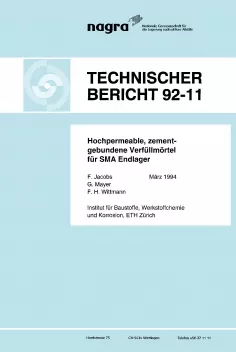
Technischer Bericht NTB 92-11
Hochpermeable, zementgebundene Verfüllmörtel für SMA-Endlager
In low- and intermediate-level waste repositories, gas is produced due e.g. to corrosion. This gas must be able to escape from the repository in order to prevent damage to the repository structure. A cement-based backfill should take over this function. For this purpose, the composition of cement-based materials was varied to study their influence on porosity and permeability. In parallel to this study the behaviour of fresh concrete (flow table test, air content, density), the liberation of the heat of hydration and the hardened concrete properties (creep and shrinkage, strength, modulus of elasticity) were investigated. To characterize the permeability of cement-based materials the following parameters are important:
- composition of the material (pore fabric)
- storage conditions (degree of saturation)
- degree of hydration (age)
- measuring fluid
A change in the composition of cement-based materials can vary the permeability by ten orders of magnitude. It is shown that, by using dense aggregates, the transport of the fluid takes place through the matrix and along the aggregate/matrix interface. By using porous aggregates the permeability can be increased by two orders of magnitude. In the case of a dense matrix, porous aggregates do not alter the permeability. Increasing the matrix content or interface content increases permeability. Hence light weight mortars are an obvious choice. Like-grained mixes showed higher permeabilities in combination with better mechanical properties but, in comparison to normal mixes, they showed worse flow properties (flow ~ 40 cm). With the composition cement : water : aggregate content 1.00 : 0.40 : 5.33 the like-grained mix with aggregates ranging from 2 to 3 mm proved to be a suitable material. With a low compaction after 28 days this mix reaches a permeability of 4 × 10-12 m2 and a uniaxial cylinder compressive strength of 16 N/mm2.
The conditioning of the samples has a strong influence. The degree of saturation and the fabric of cement-based materials change with the moisture content of the environment. For high degrees of saturation no pores are available for gas to flow through the sample. The gas pressure must be at least as high as the threshold pressure to initiate the gas flow. The lower the threshold pressure the higher the water expulsion before the gas flow starts. The threshold pressure and the permeability depend on the pore structure. Materials with high permeabilities showed low threshold pressures. Decreasing the degree of saturation increases permeability strongly. If the gas flow has started at the threshold pressure the influence of a subsequent change in the saturation on permeability is more pronounced for low porosity mixes than for high porosity mixes. Wet storage causes, besides a high degree of saturation, a condensation of the fabric. With increasing age highly permeable mixes showed a smaller reduction in the permeability than more dense mixes. The permeability decreases hyperbolically with increasing age. Hydraulic conductivity is in the range < 10-13 m2 and is lower than or equal to gas permeability.
The difference increases with decreasing permeability. With the help of three-dimensional network simulations, the influence of the pore size distribution on the transport of fluids in cement-bases materials was investigated. The gas permeability, the threshold pressure and the expulsion of water could be simulated in good agreement with the experiments.
